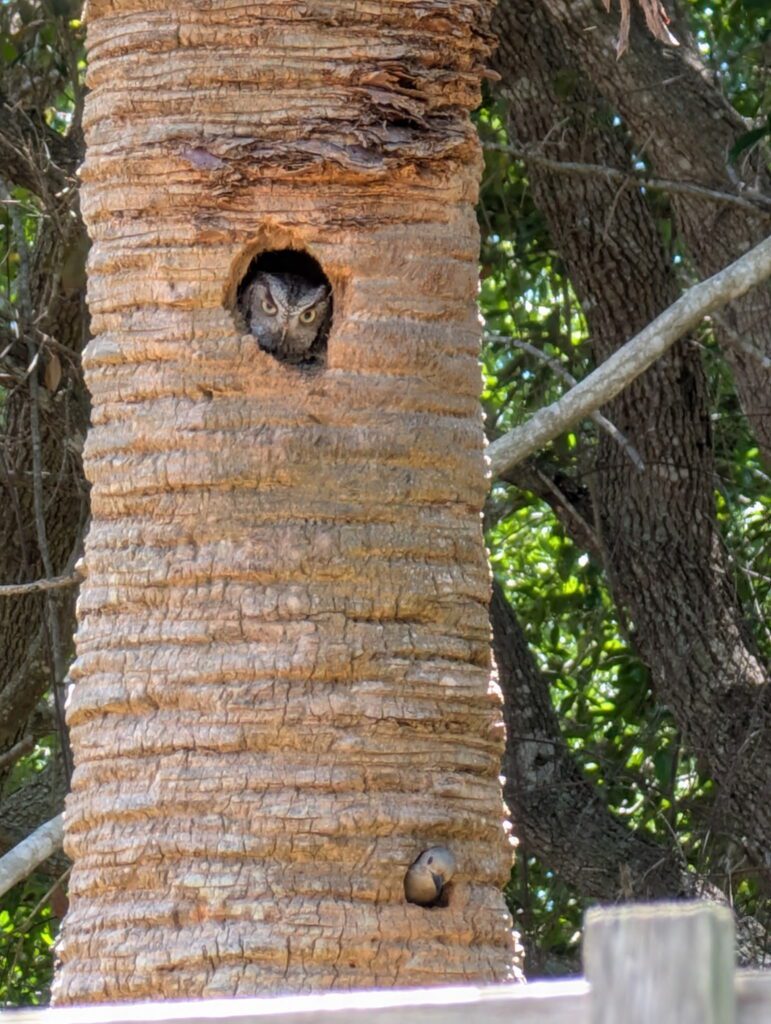Submitted by The Coccoloba Chapter of the Florida Native Plant Society
When The Coccoloba Chapter of the Florida Native Plant Society began managing River Oaks Preserve in Estero, the tasks were mostly cleaning and cutting the overgrown forest. There were years of unchecked invasives, some of which strangled out the native trees. In addition to outcompeting natives, the invasive plants reproduce faster than the cottontail bunnies. So, as we felled and mulched invasive trees and uprooted invasive shrubs, we were left with many standing wood corpses.
Generally speaking, some plants died despite our best efforts. Whether it was from hurricane damage or invasive pests or root disruption from clearing operations, or from old age or simply injuries, both seen and unseen, they simply did not survive. We were left with dead trees. So, what do you do?
As we restored the natural area and cleaned up after hurricanes in Estero, we tried to keep the dead native trees. You may ask “Why the heck would you do that”? We keep them because they are highly valuable to wildlife. Yes, that’s right! While dead trees in a suburban setting are generally considered unsightly, in a conservation setting they are a welcome addition!
A dead native tree, or snag, will generally stand upright for many years. This is certainly true with our south Florida slash pines and cabbage palms. These monument specimens will be productive for a very long time, even in death. The pines will catch airborne airplants like Spanish moss on their now-bare branches. Seeds from the giant and cardinal airplants will catch in the bark. As these plants grow harmlessly on their hosts, they in turn, host many of their own beneficial insects and microbes.
Mother Nature’s clean-up crew will also move in. Decomposer insects will start to work on the dead wood, boring under the bark and tunneling through the wood. They put out the welcome mat for fungi and bacteria to help break down the tree. Woodpeckers and other birds will hunt these woodboring insects and feast on them. It’s a smorgasbord!
The now bare branches are perfect for our biggest birds of prey to rest or scout out rabbits, snakes, rats or any other delicacy needed for the birds’ survival. Osprey will land there with their freshest sushi leaving a pile of fish bones on the ground below as the only evidence.
Two years ago, at River Oaks Preserve, the volunteers were building native plant nursery space toward the entrance to the property. There was a headless cabbage palm within about ten feet of the nursery, towering above a newly planted area. The native palm was likely strangled by an invasive fig that was still growing at the base. Who knows for sure, but it was surely headless and very dead. There was no chance it could fall or damage anyone or anything, so we kept it.
Soon enough, red-bellied woodpeckers started pecking away to create a nesting cavity. Over the following weeks, we watched the male and female woodpeckers feverishly hunting and bringing essential morsels to the babies. The Coccoloba Chapter volunteers watched, enthralled, hoping for a glimpse of a baby. Before long, the house was empty. Nesting season ended.
Last year, as the “front door” was enlarged over time, there was a flurry of activity. Woodpeckers, screech owls and starlings were spotted during “Open House” times.
These days, the Preserve volunteers watched as the red-bellied woodpecker parents pecked a new nest in this old, dead tree. Then, volunteer Brian Poelker captured the perfect Kodak moment as he toiled in the propagation area beside this most amazing snag that most people would have cut down. A screech owl face peering out of the old woodpecker abode with the red-bellied woodpecker peaking out of the modern 2025 “crib.”
Mother Nature’s perfection!
When you visit River Oaks Preserve and see volunteers staring at dead trees, now you’ll know why.
So, although some might find dead trees “unsightly,” their beauty is more than skin deep. They are a wonderfully important part of a functional ecosystem in Florida as they provide for so many species until they are completely recycled into the earth.
Feel free to stop by River Oaks Preserve, 9541 Broadway Ave E, Estero, FL 33928 to see our fabulous dead trees! We have living ones, too. Please note that mapping software works best if you use “River Oaks Preserve” instead of the address. Also, the Preserve is open to humans on Sundays and Tuesdays from 9 to 1. Other times are for bobcats, coyotes, owls, woodpeckers, hawks, spiders, snakes, rabbits, gopher tortoises and more to enjoy the land.









